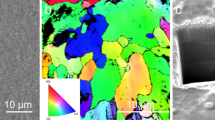Abstract
Erosion of the plasma-facing materials in particular evaporation of the materials in a fusion reactor under intense transient events is one of the problems of the ITER. The current experimental data are insufficient to predict the properties of the erosion products, a significant part of which will be formed during transient events (edge-localized modes (ELMs) and disruptions). The paper concerns the experimental investigation of the graphite and tungsten erosion products deposited under pulsed plasma load at the QSPA-T: heat load on the target was 2.6 MJ/m2 with 0.5 ms pulse duration. The designed diagnostics for measuring the deposition rate made it possible to determine that the deposition of eroded material occurs during discharge, and the deposition rate is in the range (0.1–100) × 1019 at/(cm2 s), which is much higher than that for stationary processes. It is found that the relative atomic concentrations D/C and D/(W + C) in the erosion products deposited during the pulse process are on the same level as for the stationary processes. An exposure of erosion products to photonic energy densities typical of those expected at mitigated disruptions in the ITER (pulse duration of 0.5–1 ms, integral energy density of radiation of 0.1–0.5 MJ/m2) significantly decreases the concentration of trapped deuterium.
Similar content being viewed by others
References
R. A. Causey et al., J. Nucl. Mater. 300, 91 (2002).
T. Loarer et al., Nucl. Fusion 47, 1112 (2007).
G. De. Temmerman and R. P. Doerner, J. Nucl. Mater. 389, 479 (2009).
V. Kh. Alimov et al., J. Nucl. Mater. 399, 225 (2010).
L. Begrambekov et al., J. Nucl. Mater. 438, 971 (2013).
N. Klimov et al., J. Nucl. Mater. 415, 59 (2011).
B. Riccardi et al., Fusion Eng. Des. 86, 1665 (2011).
M. Mayer et al., J. Nucl. Mater. 390–391, 538 (2009).
N. Klimov et al., J. Nucl. Mater. 438, 241 (2013).
A. Loarte, G. Saibene, R. Sartori, et al., Physica Scr. 128, 222 (2007).
N. S. Klimov, V. L. Podkovyrov, A. M. Zhitlukhin, et al., Vopr. At. Nauki Tekh., Ser. Termoyad. Sintez, No. 2, 52 (2009).
N. I. Arkhipov, V. M. Safronov, V. A. Barsuk, et al., Vopr. At. Nauki Tekh., Ser. Termoyad. Sintez, No. 4, 3 (2009).
V. M. Safronov, et al., J. Nucl. Mater. 386–388, 744 (2009).
I. M. Poznyak, N. I. Arkhipov, S. V. Karelov, et al., Vopr. At. Nauki Tekh., Ser. Termoyad. Sintez, No. 1, 70 (2014).
A. Rusinov, Yu. M. Gasparyan, S. F. Perelygin, A. A. Pisarev, S. O. Stepanov, and N. N. Trifonov, Instrum. Exp. Tech. 52, 871 (2009).
S. Krat et al., J. Nucl. Mater. 438, 204 (2013).
K. Katayama et al., Thin Solid Films 506–507, 188 (2006).
R. Doerner et al., in Proceedings of the 22nd IAEA Fusion Energy Conference, 2008.
H. Youshida et al., J. Nucl. Mater. 329–333, 790 (2004).
W. Eckstein, IPP-Report 9/132 (Garching, Germany, 2002).
N. Klimov et al., J. Nucl. Mater. 390–391, 721 (2009).
B. Bazylev et al., Fusion Eng. Des. 84, 441 (2009).
O. V. Ogorodnikova et al., J. Nucl. Mater. 415, S661 (2011).
A. Rusinov et al., J. Nucl. Mater. 415, S645 (2011).
O. V. Ogorodnikova et al., J. Nucl. Mater. 419, 194 (2011).
T. Schwarz-Selinger, A. von Keudell, and W. Jacob, J. Appl. Phys. 86, 3988 (1999).
A. B. Putrik et al., in Proceedings of the 16th Conference on Interaction of Plasma with Surface, Moscow, Feb. 1–2, 2013 (NIYaU MIFI, Moscow, 2013).
Author information
Authors and Affiliations
Corresponding author
Additional information
Original Russian Text © A.B. Putrik, N.S. Klimov, Yu.M. Gasparyan, V.S. Efimov, V.A. Barsuk, V.L. Podkovyrov, A.M. Zhitlukhin, A.D. Yarochevskaya, D.V. Kovalenko, 2014, published in Voprosy Atomnoi Nauki i Tekhniki. Seriya: Termoyadernyi Sintez, 2014, Vol. 37, No. 3, pp. 15–30.
Rights and permissions
About this article
Cite this article
Putrik, A.B., Klimov, N.S., Gasparyan, Y.M. et al. Erosion products of plasma facing materials formed under ITER-like transient load and deuterium retention in them. Phys. Atom. Nuclei 78, 1174–1186 (2015). https://doi.org/10.1134/S1063778815100105
Received:
Published:
Issue Date:
DOI: https://doi.org/10.1134/S1063778815100105




